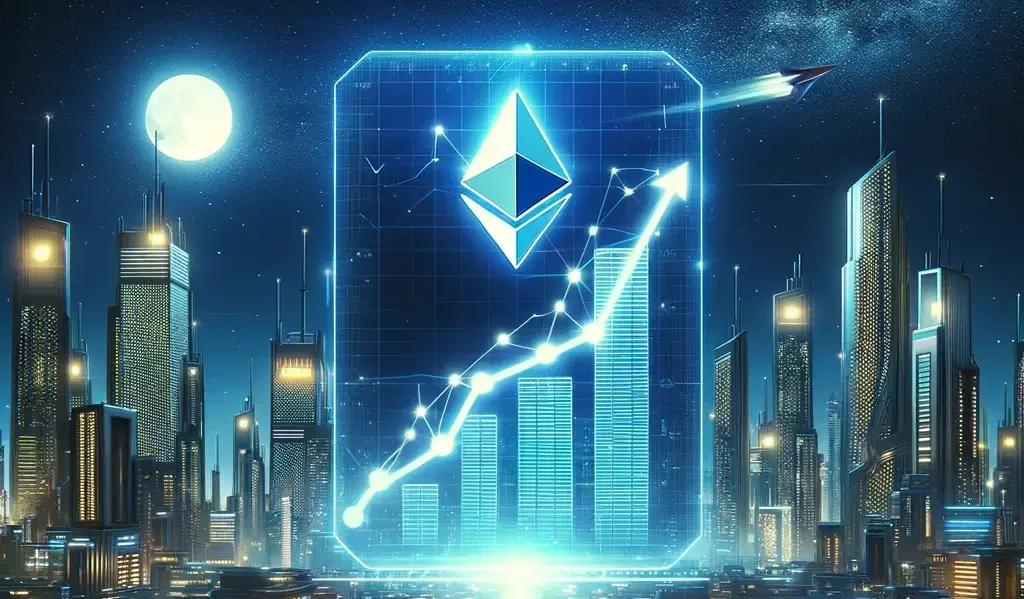You’re in the right place if you’re wondering where Ethereum’s price is heading in 2024 and beyond. This article offers an Ethereum (ETH) price prediction grounded in expert technical analysis, upcoming network developments, market sentiments, and current market conditions.
Navigate the complexity of Ethereum’s future valuation with us for clear-headed investing decisions.
Key Takeaways
- Ethereum’s price has experienced significant volatility with a history of massive peaks and sharp declines, reflecting cryptocurrency markets’ dynamic and unpredictable nature.
- Expert predictions for Ethereum’s future value in 2024 vary widely, highlighting the complexity of forecasting in the crypto industry, with influential factors including network upgrades, global economic shifts, and regulatory changes.
- Ethereum maintains a strong market position as the second-largest cryptocurrency with a diverse role beyond transactions, including smart contracts and decentralized applications, signaling a positive long-term outlook amidst evolving innovation and institutional adoption.
Based on various sources, We have compiled a pivot table of Ethereum price forecasts segmented by year. The forecasts are gathered from different analysts and platforms, each providing their view on the future price trajectory of Ethereum for the years 2024 to 2027.
It’s important to note that these predictions are highly speculative and subject to change due to the volatile nature of the cryptocurrency market.
Ethereum Price Forecast Summary
| Year | Average Minimum Price | Average Maximum Price |
|---|---|---|
| 2024 | $2,924.65 – $2,950.70 | $2,506.64 – $6,000.00 |
| 2025 | $4,559.42 – $7,472.00 | $5,160.66 – $7,472.00 |
| 2026 | $5,914.68 – $4,528.00 | $6,694.64 – $5,486.00 |
| 2027 | $7,739.85 – $4,498.00 | $8,760.49 – $8,469.00 |
The data represents a range of predicted values, showcasing both optimistic and conservative estimates:
- 2024 sees a wide range of predictions, with some sources expecting prices to range from around $2,924.65 to $6,000.
- 2025 forecasts suggest a further increase, with minimum prices starting from $4,559.42 and reaching up to $7,472.00 for maximum estimates.
- 2026 continues the upward trend in predictions, although there’s a noticeable divergence in the forecasted minimum and maximum prices, indicating increased uncertainty.
- 2027 projections show a significant rise in the minimum expected prices from $7,739.85, with the maximum prices reaching up to $8,760.49, hinting at a bullish outlook for Ethereum in the long term.
Investors must approach these forecasts with caution, as numerous factors, including market trends, technological developments, and global economic conditions, can influence the actual future prices of Ethereum. Always conduct thorough research and consider multiple sources before making investment decisions.
Ethereum’s Price Trajectory: A Retrospective Analysis

The Ethereum blockchain’s journey began with a proposal by Vitalik Buterin in 2013, and by 2015, the cryptocurrency had been officially launched at a modest price of $0.74. Its first year on Coinbase saw prices ranging from $0.93 to $21.25, indicating a promising start.
However, the first half of 2017 marked Ethereum’s breakout year, with prices skyrocketing to as high as $881.94 by December, a stark contrast to its humble beginnings.
Ethereum’s price history:
- January 2018: All-time high of $1,119.37
- December 2018: Low of $82.83
- 2019: Relatively uneventful
- 2020: Strong recovery despite initial decline due to the coronavirus pandemic
Moving to 2021, Ethereum’s price soared to a record high of $4,815.00, fueled by a bull market that pushed the crypto market’s capitalization beyond $3 trillion. This swift expansion, interrupted by severe corrections, typifies Ethereum’s history, which has seen an all-time low of about $0.42 and an all-time high of approximately $4,800 in November 2021.
For those interested in the current Ethereum price, it’s essential to keep an eye on market trends, news, and the cost of the coin.
The Future of Ethereum’s Value: Expert Insights and Predictions

Forecasting Ethereum’s future value is intriguing and challenging, with expert price predictions for ETH price for 2024 ranging from a conservative $1,849.66 to an ambitious $5,500.
Some platforms like TradingBeasts predict an upward trend in the average price of Ethereum price predictions in 2024, which can also be referred to as the “average price of ETH coin price prediction 2024 all by itself,” around $2,000, while others, like Gov Capital, anticipate eth price rally to a level of $3,500 by the end of 2024.
The variance in these Ethereum price predictions also underscores the complexity and uncertainty inherent in forecasting the future of digital currencies, making an accurate Ethereum price forecast quite tricky.
Even with these disparities, one certainty is that numerous factors will shape Ethereum’s price in 2024, including:
- Network upgrades
- Regulatory changes
- Market sentiment
- Bullish and bearish market conditions
These factors will create a spectrum of potential scenarios. We must delve deeper to understand these influential factors and their role in shaping market scenarios.
Factors Influencing Ethereum’s Price Dynamics
The scalability and throughput of Ethereum are directly impacted by its network upgrades, including the shift to Proof of Stake, shard chains, and rollups, potentially influencing the price of ETH very positively.
Upcoming upgrades like ‘Shanghai’ and ‘proto-dank sharding’ aim to enhance Ethereum’s capacity, reinforcing its value proposition significantly.
Furthermore, initiatives such as state channels, plasma, and Layer 2 scaling solutions reduce on-chain congestion, potentially reflecting positively on Ethereum’s price.
Global economic factors also influence Ethereum’s price. For example, interest rate adjustments by central banks influence investor behavior and capital flows, consequently impacting Ethereum’s pricing dynamics. Regulatory changes impacting market access and the legal framework for cryptocurrencies can also steer Ethereum’s price.
Market sentiment, measured through sentiment indices and funding rates, significantly shapes investors’ expectations, influencing Ethereum’s price movements. These factors create a dynamic and intricate ecosystem that shapes Ethereum’s price trajectory.
Potential Market Scenarios: Bullish and Bearish Perspectives
In a bullish market, Ethereum’s price can reach new all-time highs, with ETH price possibly peaking at $4,925 in 2025 and even $26,575.21 by 2030.
The optimism behind these Ethereum price predictions is reinforced by significant catalysts such as network upgrades, potential approval of spot Ethereum ETFs, and the emergence of staking mechanisms, all of which can impact Ethereum’s price and contribute to a price rise.
Conversely, Ethereum’s average price may dip to $3,917 in 2025 under a bearish market capitalization scenario and $20,647.23 by 2030 under a bearish market capitalization and condition scenario. This outlook considers the possibilities of broader market downturns, increased regulatory scrutiny, and a lack of substantial updates, which could negatively impact Ethereum’s value.
These perspectives serve as a reminder that while Ethereum’s potential for growth is substantial, it’s equally subject to the ebb and flow of the broader crypto market. As such, investors must navigate this landscape cautiously and optimistically, balancing the potential rewards with the inherent risks.
Ethereum’s Market Position: How It Stacks Up Against Other Cryptocurrencies

Ethereum is the second-largest cryptocurrency by market capitalization, boasting a market cap of $US286 billion compared to Bitcoin’s $US845 billion. Moreover, Ethereum’s resilience during market downturns suggests a growing perception of it as a ‘flight-to-safety’ asset.
This resilience, coupled with its potential to surpass Bitcoin’s market capitalization due to broader use cases and the absence of a supply cap, paints a promising picture for Ethereum.
Ethereum’s significant role in the digital asset space is primarily shaped by its unique attributes. Its blockchain technology not only facilitates transactions but also enables the execution of smart contracts and the development of decentralized applications. This positions Ethereum as more than just a digital token; it’s a platform for innovation and a catalyst for the emerging decentralized economy.
The current price trends of Ethereum are shaped by factors such as market sentiment, adoption of its blockchain solutions, and technological advancements. As Ethereum continues to make strides in sectors like DeFi and as institutions increasingly embrace it, Ethereum’s position within the broader crypto market is set to strengthen, influencing its future price dynamics.
Technical Indicators and Ethereum Price Forecasting

Technical indicators are invaluable tools for price forecasting. Bollinger Bands, for instance, reflect price volatility, with wider bands indicating higher volatility and narrower bands suggesting lower volatility.
These bands help traders determine overbought or oversold conditions, potentially signaling a price reversal. Moreover, Bollinger Band strategies such as the Bollinger Band Squeeze can alert traders to periods of low volatility that often precede significant price movements and breakouts.
The critical technical tools for analyzing Ethereum are:
- The Relative Strength Index (RSI) helps identify if Ethereum is overbought (RSI over 70) or oversold (RSI under 30), with values above 50 suggesting bullish momentum.
- Moving averages play a crucial role in spotting the emergence of bullish trends.
- The Moving Average Convergence Divergence (MACD) confirms the direction of the price trend.
These tools can be used to analyze and predict Ethereum’s price movement.
One needs to analyze Ethereum price movements across different time frames to forecast Ethereum prices accurately. This includes weekly analysis for long-term trends, daily for intermediate trends, and six-hour frames for short-term trends. Combining these technical indicators can help traders make more informed predictions and navigate the volatile landscape of Ethereum trading.
Ethereum’s Investment Appeal: Is It Worth Your Portfolio?
Ethereum’s investment allure goes beyond its price potential. Here are some key factors that make Ethereum an attractive investment:
- Ethereum’s ability to host tamper-proof decentralized contracts and applications sets it apart from other cryptocurrencies like Bitcoin.
- Its transition from proof-of-work to proof-of-stake increases network security and reduces energy consumption, demonstrating a commitment to sustainability.
- Ethereum’s pivotal role in the decentralized finance (DeFi) sector further boosts its appeal to investors.
But Ethereum’s investment appeal doesn’t end there. The active global developer and community events like Devcon and ETHGlobal meetups promote continuous innovation and foster growth, contributing positively to Ethereum’s long-term investment value. But what does Ethereum’s long-term value look like, and what are the potential risks and rewards of investing in Ethereum? Let’s explore.
Estimating Ethereum’s Long-Term Value
Ethereum’s significant role in sectors like Non-Fungible Tokens (NFTs) and DeFi underpins its long-term intrinsic value, with substantial inherent value and a high percentage of the total value locked.
This role and tremendous intrinsic value, combined with the continuous expansion and enhancement of the Ethereum ecosystem by the world’s largest developer network, powerfully positions Ethereum for sustained market dominance.
Institutional adoption and improvements in network efficiency are also critical for Ethereum’s growth. The anticipated approval of an Ethereum ETF and heightened interest from major financial players could be significant catalysts for Ethereum’s price appreciation.
Additionally, network upgrades such as Ethereum 2.0’s shift to proof-of-stake and new advancements like ‘restaking’ will positively impact Ethereum’s long-term value.
Ethereum’s dual potential as a transactional currency and a ‘store of value’ further molds its long-term price dynamics. With continuous upgrades and growth in confidence in Ethereum and blockchain solutions, Ethereum’s long-term positive outlook and price predictions remain promising.
Risks and Rewards: Assessing Ethereum’s Investment Prospects
Investing in Ethereum involves inherent risks and volatility. The high volatility in Ethereum signifies a greater risk, as it can lead to significant value fluctuations over short periods compared to assets like gold or major fiat currencies.
External factors such as increased regulatory scrutiny and actual market performance can also impact Ethereum’s risk profile and investment security.
Ethereum’s price dependence on market demand, speculation, and security risks like hacking and smart contract vulnerabilities further increase investment uncertainty. Moreover, Ethereum experiences periods of underperformance relative to other cryptocurrencies, highlighting the importance of market timing and volatility across asset classes.
Yet, investing in Ethereum can yield substantial rewards. Staking Ethereum presents potential income and capital gains, underscoring the earning potential integral to Ethereum’s investment appeal. Also, diversification benefits arise from including Ethereum in portfolios, which can help mitigate investment risk.
Ultimately, the suitability of Ethereum as an investment for an individual reflects their unique financial situation, risk tolerance, and long-term investment goals. Some experts even view Ethereum as one of the best long-term risk-adjusted investments, given its growth catalysts and resilience in diverse market conditions.
Ethereum ETFs and Their Influence on ETH Price

Ethereum Exchange-Traded Funds (ETFs) offer investors a way to tap into Ethereum’s trading volume and price movements without direct cryptocurrency ownership. These financial instruments track Ethereum’s market price, offering a simplified entryway into crypto investing.
The introduction and potential approval of a spot Ethereum ETF could act as a positive catalyst for Ethereum’s price, with predictions suggesting the average price of ETH per coin price at a potential reach of $4,900 by the minimum price of ETH in the first or second half of next year and the average price crossing five digits in 2028.
By creating a crucial bridge between traditional financial markets and digital assets, Ethereum ETFs play a role in influencing Ethereum’s liquidity and accessibility in the more significant investment landscape. By making Ethereum more accessible and easier to trade, ETFs could stimulate increased demand for Ethereum, potentially contributing to price appreciation.
In particular, the participation of institutional investors in Ethereum ETFs could markedly influence Ethereum’s price. By providing a regulated and familiar investment product, Ethereum ETFs could pave the way for more excellent institutional investment in Ethereum, enhancing its market capitalization and stability and potentially driving its price upwards.
Ethereum and the Innovation Horizon: What’s Next?
Ethereum blockchain network’s future is brimming with potential, with upcoming network upgrades and Ethereum’s expanding role in digital innovations set to influence its growth and Ethereum price prediction in 2024.
The Shanghai upgrade and other significant network enhancements are expected to profoundly influence Ethereum’s growth and price prediction in 2024, potentially leading to substantial price of ETH and price prediction gains in 2024.
“Ethereum network’s programmability has led to swift expansion within digital innovations like DeFi, NFTs, and decentralized applications (dApps) across finance, arts, gaming, and technology. This could positively affect network participation and valuation, further bolstering Ethereum’s position in the crypto market.
With the transition from Proof of Work (PoW) to Proof of Stake (PoS) improving network efficiency and Ethereum’s dominance in sectors like DeFi, Ethereum is poised to gain momentum and maintain its position as a leading blockchain platform.
The key factors contributing to Ethereum’s continued success are:
- Transition from PoW to PoS
- Dominance in sectors like DeFi
- Growing Layer-2 ecosystem
- Fee-burning mechanisms
These factors are set to enhance Ethereum’s value proposition further.
Navigating Highs and Lows: Ethereum Price Volatility
The price history of Ethereum showcases high volatility, characterized by substantial price appreciations and steep drawdowns, showcasing the asset’s unpredictable nature. This high volatility signifies greater risk, as it can lead to significant value fluctuations over short periods compared to investments like gold or major fiat currencies.
Ethereum’s volatility is also relatively higher against established cryptocurrencies, such as Bitcoin, due to its shorter history and ongoing price establishment process.
Although market sentiment can generate buying opportunities for Ethereum, the high risk of price volatility necessitates careful navigation by investors.
To manage the risk associated with high volatility, investors may consider limiting exposure to Ethereum or employing hedging strategies. Understanding and navigating Ethereum’s volatility is crucial for successful investing.
The Ethereum Volatility Index and similar indices offer insights into Ethereum’s price volatility through historical data. Recent reports from the Ethereum Volatility Index suggest 30-day volatility at 1.88% and 60-day volatility at 2.18%, which are noteworthy figures for investors.
However, improvements in Ethereum’s options market will enable better volatility measurement through implied volatility, which could offer more precise risk assessments.
Ethereum in the Context of the Broader Financial Ecosystem
Institutions’ growing adoption of Ethereum and the development of regulated fiat-to-crypto on-ramps and tokenized financial instruments facilitate its integration with the traditional finance sector. Asset managers may soon use on-chain oracles for reporting fund performance, pushing Ethereum toward greater regulatory compliance.
Consequently, Ethereum is poised to be recognized as an enhancement to traditional finance, potentially becoming the primary layer for global financial settlements.
The expectation is that regulated protocols within the financial world of Decentralized finance (DeFi) will increasingly align with the traditional financial system. Ethereum’s smart contracts can reduce the need for some forms of conventional financial regulation by solving principal-agent problems.
The practically incorruptible decentralization of Ethereum’s consensus layer provides a further consensus mechanism to prevent disputes in financial transactions.
The expectation is that the Ethereum network will penetrate traditional banking, market capitalization, market capitalization, market capitalization, and asset management, allowing crypto investors to:
- Self-custody assets through smart contracts
- benefit from Ethereum’s neutrality as an unbiased referee within the global financial system, especially in times of geopolitical instability
- utilize Ethereum’s support for various financial applications, making it a valuable addition for banks and financial organizations.
The Crypto Crystal Ball: AI and Algorithmic Ethereum Predictions
AI and algorithmic price prediction and predictions can provide a peek into the future of Ethereum cryptocurrency prices, offering a glimpse into the crypto crystal ball. AI-generated Ethereum and other such price predictions draw on historical price movements, trading volumes, and technical analysis indicators.
A hybrid algorithm that combines Genetic Algorithms (GA) with Artificial Neural Networks (ANN) has even shown superiority in forecasting Ethereum prices, outperforming traditional models.
Although AI can notably enhance price prediction and forecasting in Ethereum markets, its reliability hinges on a balanced integration with human expertise. The effectiveness of AI in cryptocurrency price prediction is challenged by human emotions and market sentiment, which are difficult for algorithms to account for.
Deploying AI unchecked in market analysis could result in increased volatility and risk of market manipulation, as the technology has the potential to amplify market trends. Nevertheless, using AI in trading, devoid of emotions, can prevent panic-selling and miss out on intuitive trading decisions prompted by human sentiment.
While AI and algorithmic predictions offer intriguing insights, they should be balanced with human expertise and a keen understanding of market sentiment.
Summary
From its inception to its current standing as the second-largest cryptocurrency, Ethereum has demonstrated remarkable growth and potential. Its price trajectory, influenced by myriad factors from network upgrades to market sentiment, has seen significant highs and lows.
Despite the inherent volatility and risks, Ethereum presents a compelling investment appeal, backed by its integral role in DeFi, NFTs, and continuous network upgrades. The potential introduction of Ethereum ETFs and its growing integration into the traditional financial ecosystem further underscore its significance.
While expert predictions and AI forecasts provide intriguing insights into Ethereum’s bright future ahead, the final verdict rests with the market dynamics. As we continue to navigate the ever-evolving crypto landscape, one thing is sure: Ethereum is a force to be reckoned with.
Frequently Asked Questions
How much will Ethereum be worth in 2025?
Ethereum’s minimum price prediction in 2025 is predicted to range between an average Ethereum price prediction in 2024 of $4,500 and a minimum Ethereum price prediction in 2024 of $6,500, with an above-average minimum price prediction in 2024 of around $5,500. By 2030, Ethereum price prediction 2024’s market capitalization is expected to reach a maximum of $20,500.
Can Ethereum Classic reach $10,000?
No, it is implausible that Ethereum Classic will reach $10,000 anytime soon, as price prediction is based on price prediction and algorithms.
What was the highest Ethereum price?
The highest price of Ethereum was $4,721.07. Ethereum has shown strong growth over the years.
What is the price prediction for ETH stock in 2030?
In 2030, the minimum per price of ETH prediction for Ethereum stock ranges from $68.11 to $128.37, indicating a significant drop in the trading price of eth then, trading volume, cost, market capitalization, market capitalization, and potential growth.
What will Ethereum be worth in 2024?
In 2024, Ethereum is predicted to have an average price ranging between $2553.62 to $3830.43. There’s potential for the ETH average price in price prediction to rally to reach $5000 by the end of the year.
Ethereum is expected to achieve high levels of average price and prediction in 2024, with Ethereum’s average price prediction in 2024 forecasting a maximum potential price of ETH $ 6,500 by 2025.
Disclaimer: The content on this site should not be considered investment advice. Investing is speculative. When investing, your capital is at risk.







